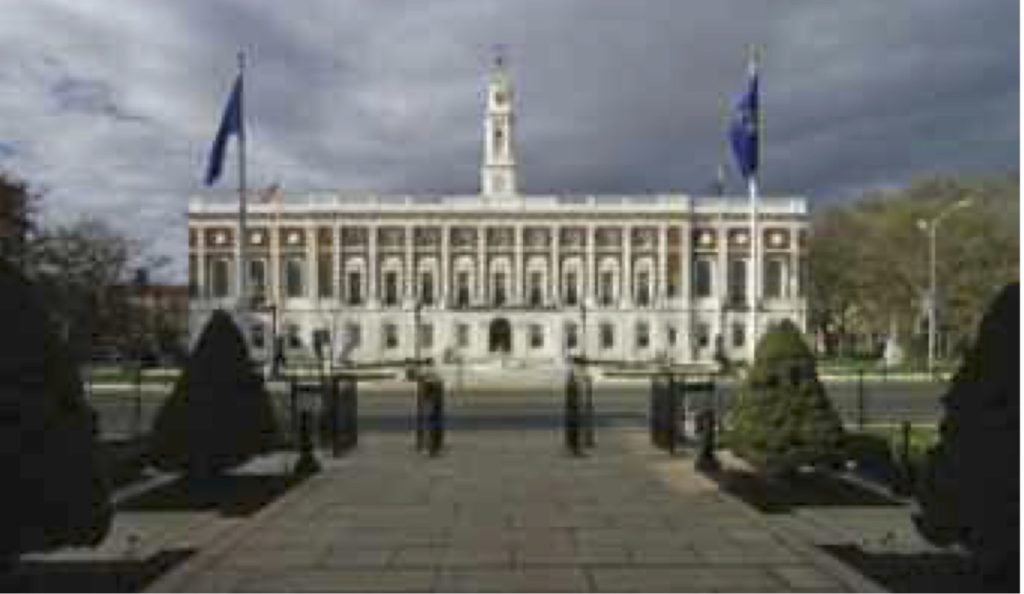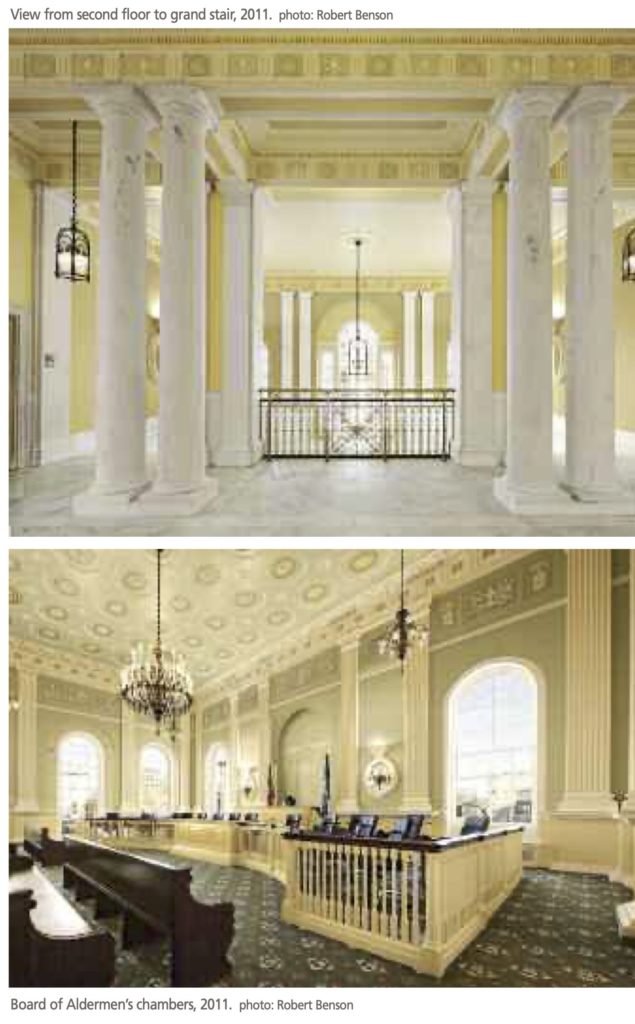By Robert W. Grzywacz
(c) Connecticut Explored Inc. Fall 2011
Subscribe/Buy the Issue!
I knew it could be important. I knew it should be big. I knew I wanted to be a part of making it happen.
When I first saw Waterbury City Hall it was nearly vacant, run down, drab, and showing the effects of decades of deferred maintenance, ad hoc “improvements,” and far more “government green” flat paint than should be inflicted on any building. Grass grew between the frost-heaved pavers of the Entourage, marble stair treads were so badly dished from wear that those on the exterior ponded and froze solid in the winter, and the interior was dim and full of the detritus of office occupation.

Waterbury City Hall and fire station, built in 1915 and restored in 2011. photo: Robert W. Grzywacz, DeCarlo & Doll Inc.
But as an architect I could tell it was a good building. It had a grandeur and dignity carefully calibrated to the stature of a rising industrial metropolis. It was built with best materials: Marble predominated both inside and out. I knew of no other municipal building in the state that could claim to be its peer. As I researched the original architect, Cass Gilbert, architect of the U.S. Supreme Court and New York’s Woolworth Building, I learned it was a great building of national significance. I signed up to lead DeCarlo & Doll’s team to restore the building.
In 2006, the city of Waterbury was forced to close its City Hall. Vandalism in 2005 and 2006, including the opening of fire-fighting standpipes that flooded the building and caused massive internal water damage including delaminating plaster and systemic mold infestations. Much of the city government had already moved elsewhere, including to the Chase Building across the street. Cited for multiple code violations, the building was vacated.
Local opinion as to what to do with the 1915 building was divided. A vocal segment of the public called for selling it to a developer and permanently moving city offices to rental space. When the board of aldermen proposed renovation, voters rejected that proposal in a referendum.
A grassroots preservation movement emerged, however, spearheaded by the local Mattatuck Museum. The museum held a symposium in April 2007, sponsored by the Connecticut Community Foundation, to examine City Hall’s place in American architectural history, and its importance to the city. The symposium drew attendees from all over Connecticut and beyond and through its overflow attendance and strong local support demonstrated the building’s importance for Waterbury. Alan Plattus, professor at the Yale School of Architecture noted that most communities want a centrally located, visually prominent municipal building that is an easily accessible gathering place for doing public business, and that fosters a sense of civic identity. “We need places like this to come together and remember who we are,” he said. Mayor Michael J. Jarjura made restoration his personal issue, and the aldermen drew up a revised program and budget that won substantial public support.

top: View from second floor to grand stair, 2011. photo: Robert Benson. bottom: Board of Aldermen’s chambers, 2011. photo: Robert Benson
From an architectural perspective, City Hall clearly was worth restoring. The building was substantially constructed in a Colonial Revival style with overtones of the Renaissance in its scale, ornament and civic presence. It was the centerpiece of a civic cluster that ultimately included four other Gilbert buildings; together they now make up the Cass Gilbert National Register District (a federal designation awarded by the National Park Service).
But over the years the building suffered from deferred maintenance and insensitive alterations. Removal of lead flashing (apparently in a World War II scrap drive) caused walls to deteriorate. Utilitarian partitions chopped up grand spaces, dropped ceilings concealed crown moldings, and bland paint covered richly colored decorative schemes. The mayor and board of aldermen had abandoned their ceremonial chambers, which had been designed to symbolize their roles in city government.
The goal of the restoration, designed by my firm DeCarlo & Doll, Inc. of Meriden, was to restore not only City Hall’s architecture but also its functional and symbolic place in the community. City departments frequently visited by the public were returned to the building; each received an architectural portal, inspired by the vocabulary and spirit of Gilbert’s design, which expressed the dignity of city government and structured the interaction between the individual citizen and the city staff. The message of this building is that you’re not just slouching in to pay your tax bill. You’re participating in the privileges and responsibilities of citizenship.
The $32-million restoration completed, City Hall was rededicated on January 1, 2011, and over the next weeks over a thousand people toured the building. They saw that 100 percent of the original building shell and approximately 80 percent of all interior partitions and finishes were retained. Current safety and accessibility codes were met by, among other things, adding three egress stairs and an additional elevator, allowing the grand stair and adjacent halls to remain undivided by fire partitions. New mechanical, electrical, plumbing and fire suppressions systems were located to minimize their impact on historic building fabric. Original spaces were restored to their original configuration and finishes, including original color schemes determined by paint analysis.
Most important, City Hall is being used: the Mayor and Aldermen are back in their original quarters, and the public is in and out, carrying out business with various city departments, where new public service counters and cashiers stations, based on elements of Gilbert’s designs, provide a consistent and dignified setting for interactions between citizens and public servants. In the Aldermanic Chamber, seating was reconfigured, within Gilbert’s vocabulary, to allow a face-to-face relationship between the aldermen and the citizenry.
Gilbert’s great granddaughter Helen Park Curry, noted wrote (in a letter to the National Trust for Historic Preservation in support of a Trust award for the project), “Since my early childhood I have known that Gilbert’s motto was, ‘Do it right or don’t bother’ so that afterwards you could say, ‘No effort was spared.’ The mayor, the board of aldermen and the people of Waterbury did just that. [T]hey spared no effort in saving and preserving this glorious national treasure.” The local feeling about the finished project is summed up well by resident Carolyn F. Ciccetti: “The day the brass ribbon was cut, crowds poured in to see what had been a public mystery. Everywhere one looked citizens glowed with pride. And the most often heard comment was ‘It was worth every penny.’”
“Longer lasting than brass”—Waterbury’s motto—expresses the city’s ability to overcome seemingly insurmountable difficulties. This was true in 1915 when the municipality dedicated the then new City Hall, replacing an earlier building that was destroyed in a devastating fire in 1912. It is true now, as well, as the rededicated City Hall symbolizes Waterbury’s efforts to re-invent itself after the indignities of the late 20th century: the loss of its once dominant brass industry, the collapse of the city’s economy, and multiple corruption scandals. Revitalization efforts are beginning to bear fruit in such projects as the restoration of the Palace Theater and the opening of the University of Connecticut’s new downtown campus. But it is the restoration of City Hall that has captured the public’s imagination.
Marie Galbraith, executive director of the Mattatuck Museum, sums up the feeling of many in Waterbury, “The city’s leaders and the restoration team who worked on this project deserve great praise; City Hall is breathtakingly beautiful. We hope that the success of this project will inspire a plan for the restoration and development of our city’s center.”
Robert Grzywacz is vice president of DeCarlo & Doll, Inc. Architecture Studio.
EXPLORE!
Read more Historic Preservation stories on our TOPICS page.
